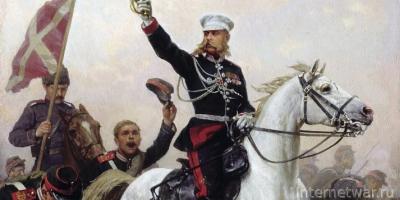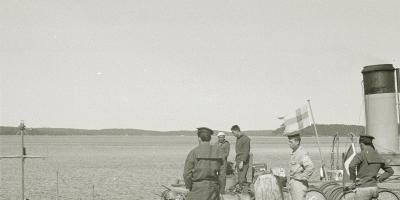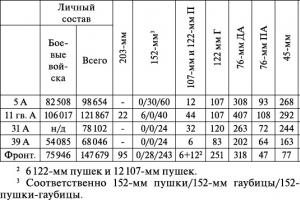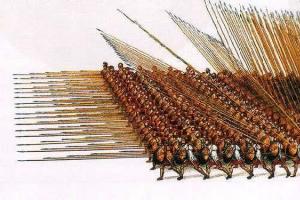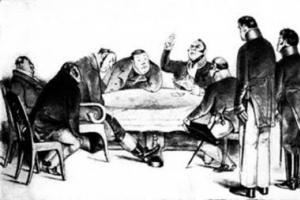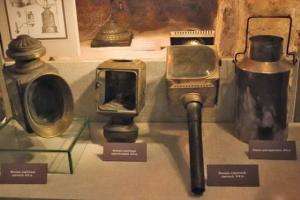Based on materials from the book "Northern Wars of Russia" (
In accordance with the decision of the Commander-in-Chief of the North-Western direction, Marshal K.E. Voroshilov, by order of the Deputy People's Commissar of the Navy, Admiral I.S. Isakov, on the basis of the Onega naval base of the Ladoga military flotilla, the Onega military flotilla was formed. Its commander was the former commander of the Onega naval base, Captain 2nd Rank A.P. Dyakonov.
In August-September 1941, in the ship repair shop in the village of Voznesenye, the tugboats of the White Sea-Onega Shipping Company "Auguste Blanqui" (KL-11), "Kalyaev" (KL-12), "Izhorets No. 18" (KL-13) were converted into gunboats ), "Martiets-89" (KL-14) and "Martiets-60" (KL-15). In October, mortars were received for them.
The gunboats were initially armed with two old 75 mm cannons, 1 45 mm anti-aircraft gun, and one 82 mm mortar. In 1943, they were re-equipped with 2 85 mm cannons and 3 coaxial 12.7 mm Colt machine guns. In addition, they still had mortars.
On September 18, 1941, the Finns cut the Svir River in the Ostrechina area and occupied Gakruchey. To support ground units, KL-12 was sent to this area from Voznesenye. On September 19 at 7.30, having approached the village of Ostrechina at a distance of 1.5-2 km, the gunboat fired at it. A construction battalion (100 people) with equipment was released from captivity. A few hours later, the gunboat fired at the village again and forced a group of Finns to retreat. This operation became the flotilla's baptism of fire.
On the same day, KL-12 climbed up the Svir to the village of Vyazostrov, where it covered the evacuation of the population, preventing the enemy from crossing to the left bank. KL-12 and KL-14 successfully fired at the enemy in the area of the village of Gakruchey. The village was occupied by Soviet soldiers who landed from the tugboat "Salmon".
On September 21, KL-13 shelled the outskirts of the village of Gakruchey. A warehouse of ammunition and equipment was destroyed by a direct hit. The enemy retreated. On September 22-24, KL-13, KL-14 and the tugboat "Losos", which carried 72 soldiers of a separate road construction battalion and 27 fighters of the people's militia, entered a combat position in the area of Vyazostrov and Gakruchi. They received orders to occupy the village and prevent the enemy from crossing to the left bank of the Svir. But the attack of the Soviet troops was repulsed.
From September 26 to 28, the KL-13 gunboat shelled the village of Proshino, firing more than 180 shells. From October 2 to October 5, the gunboat division, having taken up positions in Svirskaya Bay, fired at enemy concentrations for four days, expending 511 shells.
On October 7, the Finns occupied Voznesenye and were stopped south of the city in the area of the Oshta River. On October 8, the commander of the 272nd Infantry Division, Major General M.S. Knyazev, who headed the ground defense along the Oshta River, set the Onega flotilla the task of preventing the enemy’s advance in the Voznesenye-Oshta sector with naval artillery fire. Gunboats KL-11 and KL-13 attacked enemy firing points at Cape Kulikov and Kamennaya Ridge. On October 10, with the support of gunboat fire, Soviet troops repelled Finnish attacks.
From October 11 to October 24, gunboats KL-11, KL-13 and KL-15, being in the Onega bypass canal and near the southern shore of the lake, fired at enemy firing points, supporting attacks by ground units. They also prevented the enemy from crossing the Svir, the advance of reinforcements, and the delivery of ammunition and supplies. 1,375 shells were spent. Soviet troops held the Oshta line.
During the retreat of Soviet troops on Svir, Petrozavodsk and Povenets, over 20 serviceable steamships and tugs were abandoned. At the beginning of October 1941, the Finns began converting them into gunboats and patrol ships. Petrozavodsk became the main base of the Finnish flotilla.
In mid-October, a detachment of armored boats consisting of BKA-35, BKA-63, BKA-64 and BKA-65, transferred from the Ladoga military flotilla, arrived in Vytegra.
But soon the armored boats along the Vytegra and Mariinsky system went to Molotov (Perm) for the winter. The gunboats were also supposed to go to Molotov, but ice stopped them in the city of Gorky. On November 28, 1941, by order of the People's Commissar of the Navy, the Onega Flotilla was disbanded, and its ships were transferred to the Volga Military Flotilla. On April 30, 1942, by order of the People's Commissar of the Navy, the Onega detachment of ships was formed from the Volga military flotilla. It consisted of the headquarters ship "Moskovsky Komsomolets" (former network minelayer "Iset"), 6 gunboats (KL-11, 13, 14, 15, 40,41), 8 armored boats (BKA-11,12, 31, 32, 35, 63,64, 65), 7 patrol boats and minesweeper boats, 4 gliders, water area protection forces, 31st separate marine battalion, surveillance and communications service, logistics department, warehouses and production plants. The Onega detachment of ships was directly subordinate to the People's Commissar of the Navy, and operationally to the commander of the 7th Separate Army. The bases for his ships were the Vytegra River, the Obvodny Canal, the Andoma and Vodla rivers.
On June 7, all ships, except armored boats, arrived in the city of Vytegra, and the detachment began to carry out combat missions. The armored boat division, consisting of two detachments of four boats each, arrived at Vytegra on June 16 and began combat activity on June 21.
At the Onega Lake Theater by this time the following operational situation had developed. The western shore of the lake from Voznesenye to Povenets with bays and piers convenient for anchoring ships was in the hands of the enemy. The northern and southern parts of this coast were fortified by a coastal defense system, consisting of separate garrisons and batteries. In the northern part of the lake on the Zaonezhye peninsula and some islands, the Finns installed long-range batteries and kept the entire shore under fire from Cape Orov-Navolok to Orov-Guba.
The eastern shore of the lake was guarded by units of the 7th Separate and 32nd armies (the demarcation line along the Vodla River). In the north from the Vodla River to Chernaya Bay, the 80th Infantry Regiment of the NKVD troops, which was part of the 32nd Army, occupied the defense. South of the Vodla River to the Vytegra River stood the 185th separate rifle battalion of the NKVD troops.
The coast from the Vytegra River to the mouth of the Oshta River was occupied by units of the 369th Infantry Division. The 1st Guards Pe-2 bomber squadron was based in the village of Devyatina.
In accordance with the tasks set by the command of the 7th Separate and 32nd armies, two independent directions of the detachment’s combat activities emerged: southern and northern. Subsequently, a detachment of ships ensured the defense of the city of Vytegra and convoyed ships in the Vytegra - Shala sections; Vytegra - Andoma.
The northern (Shal) group of ships, consisting of three armored boats, two gunboats and a patrol boat, provided the left flank of the 32nd Army (80th Infantry Regiment), guarding the eastern coast of the Povenets and Zaonezh gulfs. The group's tasks included reconnaissance, patrol, protection of communications, and landing of reconnaissance groups. During combat activities, the landing of reconnaissance groups acquired the greatest importance. For this purpose, KM boats and armored boats were used. In two months, 126 people were landed behind enemy lines. At the same time, the previously landed groups were removed from the shore. From June to October, the northern group made more than 70 combat missions, including 27 on patrol, conducted 5 artillery attacks, and landed 15 reconnaissance groups.
The southern group of ships supported the flank of the 368th Infantry Division together with the 31st Separate Marine Battalion, which defended the coast from Cape Black Sands to the mouth of the Vytegra River (then to Tudozero), conducted reconnaissance, search and artillery raids, and carried out patrol duty. Raiding operations, in which gunboats and armored boats participated independently and in cooperation with aviation, became important. Ships and boats fired at enemy coastal targets 30 times. In the southern direction, from June to October, 160 combat exits were made, including 30 for artillery shelling, 3 for search, 107 for patrol.
On July 31, 1942, the KL-13 gunboat (formerly the Izhorets-18 tug) landed a reconnaissance group in the area of Vasilisin Island and then went missing. According to popular Soviet literature, she died in a storm; according to closed data, the cause of death is unknown. In mid-November 1942, the Onega detachment of ships along the Mariinsky system went to the city of Rybinsk for the winter. The 31st separate marine battalion was left to defend the southeastern coast of Lake Onega.
By the beginning of 1943, the defense of the coast of Lake Onega, occupied by the Finns, consisted of separate garrisons, resistance centers, which included mobile and stationary batteries, as well as two fortified areas. The first fortified area included the area from the city of Petrozavodsk to the village of Voznesenye (defended by the 1st Onega Coastal Defense Brigade), the second included the Zaonezhye Peninsula and Bolshoy Klimetsky Island (defended by the 2nd Onega Coastal Defense Brigade). Finnish artillery was located by battery or by gun.
The Finnish lake flotilla consisted of four gunboats (total armament - three 102 mm and five 76 mm guns), three armored boats (three 76 mm or 45 mm guns), three high-speed barges and several boats, two mixed squadrons (Ju-88, He-111, Me-109, "Curtis"), based at airfields and sites in the Petrozavodsk area.
By order of the People's Commissar of the Navy dated December 31, 1942, the Onega detachment of ships was renamed the Onega military flotilla. Ships and vessels of the flotilla in three echelons arrived in Vytegra from May 14 to June 14. By the beginning of the 1943 campaign, the KL-13 gunboat was returned from the Volga Flotilla, and the headquarters ship Moskovsky Komsomolets was repaired, re-equipped and reclassified as a gunboat. In addition, 8 patrol boats (No. 3, 4, 5, 6, 47, 49, 104, 111), 7 torpedo boats of the G-5 type (No. 81, 82, 83, 84, 91, 92) were introduced into the flotilla , 93), 3 minesweeper boats (RTShch-130, 131 and 132), 2 patrol ships (SKR-14 and 5).
On May 16, the ships of the flotilla began escorting transports and tugs with barges that delivered cargo to units of the Red Army. The main routes were lake communication (Vytegra - Andoma River - Shala Bay) and communication along the Onega bypass canal (Vytegra - Kedra village).
On the night of May 31, gunboats KL-11 and KL-41, armored boats No. 12, 22, 41 and 42 (172) fired at the villages of Podshchelye and Ropruchey. As a result of the shelling, it was not possible to establish the location of enemy firing points, since the enemy did not return fire. On June 1, gunboats KL-11, KL-12 and KL-41 searched the Finnish communications in Petrozavodsk Bay, but were discovered by Finnish aircraft. As a result, the enemy ships took refuge in the bay, and the search yielded no results. At 13.45, near Vasilisin Island, gunboats suddenly attacked three Finnish aircraft that had come from the direction of the sun. KL-12 was hit in the stern by two 100 kg bombs and sank. Gunboats KL-11 and KL-41 received no damage.
“After the death of KL-12, the division commander, Captain 2nd Rank G.I. Ginzburg, fearing a second attack, decided to disperse the ships. He ordered the commander of KL-41 to rescue the personnel of the deceased KL-12, and he himself, together with Captain 2nd Rank G.S. Gapkovsky on KL-11 went to the base. KL-41 headed to the place of death of KL-12 to save the personnel, but the enemy plane attacked the gunboat a second time. The ship began to maneuver and fire back. Driven away from the gunboat by artillery fire, the enemy plane fired from machine gun floating personnel of KL-12. 8 people were killed. Only at 14:36 minutes KL-41 approached the place of death of KL-12 and saved 22 people (27 people died), including the ship commander."
On the same day, near the mouth of the Vytegra, three Finnish aircraft damaged the RTShch-130 minesweeper boat. And on the night of June 9, a convoy traveling from the Ozernoye mouth to Shala was attacked near Cape Muromsky. A barge containing flour was damaged. Several Finnish air raids on Soviet ships occurred in the following days. In total, in June 1943, Finnish planes attacked Soviet ships 30 times.
“The enemy did not return fire, so it was not possible to find out the location of his firing points and coastal defense system.”
It is likely that there was no one else there except local residents.
On July 8, armored boats No. 12 and No. 21 headed to the Gimoretskaya Bay area to search for enemy ships. To support them, KL-40 and three torpedo boats were located at the Onega mouth. At 16.20, the armored boats discovered a tug with a barge and an enemy motorboat, sailing from Cape Chey-Navolok to Gimoretsk Bay. Having approached the ships, at 16.45 the armored boats opened fire from two 76-mm cannons. The Finnish ships, increasing their speed, turned to the shore under the cover of their coastal batteries. At 16.15, fire was opened on the ships from Cape Chey-Navolok and from the area of the village of Kaskiruchey with 100-mm guns. The Finns did not have effective fire control devices even on the Baltic 305-mm and 254-mm coastal batteries, and even more so in Karelia, so the probability of hitting a small boat was negligible. And the armor protected the boat from fragments and shrapnel. But the boat commanders simply chickened out and took the opposite course. This is how the first contact with Finnish ships on Lake Onega ended shamefully.
On July 23, the large hunter of Project 122 “Mars”, accepted from industry, joined the Onega flotilla.
On August 19-22, a detachment of ships of the Onega flotilla, together with the 1228th Infantry Regiment of the 368th Infantry Division of the 7th Army, carried out an operation to destroy an enemy stronghold adjacent to the front at the mouth of the Oshta River. In this area, the enemy had a three-gun 120-mm battery (Cape Kulikov), 10 batteries of 76-152 mm guns, an air defense battery at Cape Korovenets, and mortar and machine-gun points. The flotilla was entrusted with the task of artillery support for the offensive of the 368th Infantry Division in the Vozheroksy area.
The ships were brought into two groups. The first group included gunboats KL-11 and KL-41, armored boats No. 21 and No. 42, patrol boats No. 41 and No. 42 with M-13-M rocket launchers (16 - 132 mm shells) and was supposed to operate from closed positions in Onega bypass canal. The second group of ships, consisting of torpedo boats Nos. 81, 82, 83, 91, 92 and 93 with M-8-M rocket launchers (24 - 82 mm shells) was supposed to fire from the lake.
At 4.01, the torpedo boats, while on the move, fired a salvo. The task was successfully completed. At the same time, a PC salvo was fired at the enemy stronghold from two patrol boats stationed in the canal. Then came the second salvo. After this, the enemy fire weakened significantly. After the end of the artillery preparation, units of the 368th Infantry Division went on the offensive. Supporting the advancing infantry, armored boats No. 21 and No. 42 suppressed firing points and destroyed enemy personnel with direct fire. The gunboats fired from indirect positions. Three armored boats received significant damage from enemy fire. The commander of armored boat No. 21, Lieutenant I.I., was killed. Chebotarev and the chief gunner, two sailors were wounded.
As a result of joint actions, the enemy was knocked out of their positions, units of the 7th Separate Army moved forward and captured a section of the southern coast of Lake Onega.
On September 13 at 1.05 am armored boats No. 21 and No. 42 under the command of the commander of the gunboat division, Captain 3rd Rank I.P. Nikulin landed a group of scouts on Cape Chey-Navolok. On the way back at 3.05, the silhouettes of three ships were noticed from the lead boat. Without responding to the identification signal of the armored boats, these ships opened artillery fire. And again the commanders of the armored boats did not want to engage in battle. Having laid a smoke screen, they turned back.
At 7 o'clock in the morning on September 14, a detachment consisting of armored boat No. 12, torpedo boats No. 83 and No. 93 near Lesnoy Island discovered a Finnish tugboat standing off the coast. At 7.26, from a distance of 4.4 km, the boats fired at the tug with rocket launchers. The shells landed at the target location. At the same time, the Finnish coastal battery opened fire on the boats from Cape Rid-Navolok. Behind her, the second enemy battery opened fire. Having reloaded the installations, the boats fired a second salvo at 8.08 - at the enemy batteries. According to the report of the detachment commander, of the six guns that were fired, five were disabled, and a fire broke out on the ship. However, it is unlikely that rockets would hit the ship at such a distance, and one can only guess how the commander could find out that exactly five guns were out of action. But why armored boat No. 12 did not fire from its two 76-mm cannons is not clear. He really could have sunk the ship.
On the night of September 24, armored boats Nos. 21, 22 and 41, as well as the minesweeper RTShch-31, landed a reconnaissance force of 50 people on Ivantsov Island. When landing on the island, due to inept handling of land mines, an explosion occurred on one of the boats. In this case, 7 people died. The scouts were discovered by the enemy, who opened fire. The landing force had to be taken on board again. The armored boats fired 26 shells at the Finns and went back.
On the night of September 27, patrol boats Nos. 41, 42, 43 and 44 fired (in two salvos) 128 132-mm M-13 rocket projectiles at a four-gun 122-mm battery near the village of Zhabinets. On the night of October 5, the same boats fired 176 shells at the same battery, but did not hit the battery.
On October 10, torpedo boats Nos. 81, 83 and 93 fired two salvos of 82-mm M-8 shells at the pier near the village of Shcheleyki, and the large hunter "Marsovaya" fired from a 76-mm gun from the maximum distance. Finnish batteries from Cape Sambo, Chapel and from the villages of Podshchelye and Shcheleyki returned fire. The shells landed near the boats. Boat No. 83 was damaged, but remained afloat.
On the night of October 26, Marsovoy and KL-41 landed a group of reconnaissance aircraft on Cape Brusnichny. This was the end of the military operations of the Onega military flotilla in 1943. It should be noted that, despite the great superiority in forces, the command of the Onega flotilla remained passive. During the entire campaign, the ships of the flotilla did not sink a single Finnish ship. It is not clear why the flotilla did not lay mines on enemy communications, in particular, in the Petrozavodsk area? In the last days of October 1943, the ships of the flotilla left for the winter in Cherepovets and Rybinsk.
The first echelon of the flotilla returned to Vytegra on May 8, 1944. From June 23, 1944, the ships of the flotilla supported the advance of the 368th Infantry Division in the area of the village of Voznesenye with artillery fire. During the offensive of the troops of the 7th Army, the ships of the Onega flotilla carried out a successful landing of tactical landings: on June 23 - on the island of Bolshoi Klimetsky, on June 26 - near Sheltozero.
“About 7 o’clock in the morning, our aviation bombed and fired at the coastal strip of Uyskaya Bay, and gunboats, mine boats and armored boats opened heavy fire along the shore, suppressing the enemy’s anti-landing defense. Following this, the landing of the Marine Corps began, first from... and armored boats, and then from the rest of the ships. The gunboat "Moskovsky Komsomolets", whose draft did not allow it to come close to the shore, reloaded the landing force onto the boats. By 8:40 a.m. the landing was basically completed.
Overcoming enemy resistance, Soviet paratroopers liberated the village of Derevyannoye and the railway station; then some of them headed along the road to Petrozavodsk."
Everything would be fine, but there was no longer an enemy either on the coast of Uyskaya Bay, or in the village of Derevyannoye, or in Petrozavodsk itself. To avoid unnecessary losses, the Finnish command withdrew its troops in advance. Having learned about this, the commander of the Onega flotilla, Captain 1st Rank Antonov, ordered a landing in the Petrozavodsk port. On June 28, in the afternoon, the ships of the flotilla entered Petrozavodsk and landed units of the 368th Infantry Division there. This marked the end of the fighting on Lake Onega.
Italian torpedo boat MAS 527 off the northern coast of Lake Ladoga, June 1942.
The boats MAS 526, MAS 527, MAS 528 and MAS 529, the 12th division of torpedo boats of the Italian fleet, under the command of Capitano di Corveto D. Bianchini, arrived at Ladoga in July 1942 to operate as part of the allied Finnish-German Italian connection.
The main tasks of the united flotilla and the Finnish and German Air Force squadrons attached to it were to counter Soviet forces on Ladoga (Ladoga Flotilla) and attack transports supplying besieged Leningrad through the waters of the lake.
During the battles of the summer-autumn of 1942, the Italian boat crews failed to achieve any significant results, and in October 1942, in view of the imminent end of navigation, the Italians left Finland.
In general, the Finnish-German-Italian forces were able to inflict damage on the Ladoga flotilla, but mainly through air strikes. Attempts to disrupt Soviet communications on the lake ended in complete failure, the peak of which was the failed landing on Suho Island on October 22, 1942.
It must be said that Italian boat boats deservedly had a high reputation (since the First World War), but in an unfamiliar theater of military operations, which was Ladoga, which was very different from the southern Mediterranean, it was, of course, difficult for them. In addition, reconnaissance of the Baltic Fleet promptly discovered the formation of an enemy flotilla on the lake and the Soviet command took countermeasures.
Below are photographs of Italians in Finland and Ladoga in 1942.

Z apraka boats with fuel, Finland June 1942

Sailor sentry on the pier, Finland June 1942

Boat at the pier, Finland June 1942

Finnish army lieutenant and Italian sailors, Finland June 1942

Sentry at the boat, Finland June 1942

Italian lieutenant, Finland June 1942
An interesting officer. On the sleeve of the army uniform there are stripes of a naval lieutenant, on the chest there is the badge of an Air Force pilot, a cap with a grenada and the number eight. Fleet anti-aircraft artillery lieutenant?

Sailors on the deck of a boat, Finland June 1942

Commander of the boat MAS 528

Captain D. Bianchini, Kriegsmarine officer Helmut Leissner and Luftwaffe Lieutenant Colonel Fritz Siebel, Ladoga August 1942.


Captain D. Bianchini and sailors in the camp at the boat base on the shore of Lake Ladoga, near the village of Sortanlahti, September 1942.

Soldier and sailors with a cart on a forest road, northern shore of Ladoga, autumn 1942.




Boats at the base in the village of Sortanlahti, autumn 1942.





Awarding of Italian sailors by the Finnish command, Sortanlahti October 1942
History of the Finnish Navy
History of the Finnish Navy
Since 1323, Finland was part of the Kingdom of Sweden; in 1808-1918 was part of the Russian Empire, under the name of the Grand Duchy of Finland, on the territory of which the naval bases of the Imperial Russian Navy of Helsingfors and Sveaborg were located.
Finland created its own armed forces in January 1918, immediately after the declaration of independence.
At the same time, the beginning was made of the creation of a national navy. Initially, they consisted of ships and vessels of the Russian fleet, which for various reasons could not take part in the “Ice” campaign of the Baltic Fleet.
In 1920, the Dorpat Peace Treaty was signed, according to which Russia officially recognized the independence of Finland. Immediately after this, attempts were made to develop their own Navy, but still for almost ten years the Finnish fleet did not play any role in the Baltic. It consisted only of former Russian ships, the personnel was 57% Swedes, and the Navy itself was not an independent structure, but was part of the coastal defense.
In 1921, a draft of the first shipbuilding program was submitted to parliament, according to which it was planned to build 6 armored gunboats, 4 destroyers, 8 escort ships, 4 submarines, 30 torpedo boats and one training ship. But due to the high cost, the program was not adopted. Significant changes were made to the project, and in 1927 a new version was adopted, according to which it was supposed to have: 2 coastal defense battleships, 4 submarines, 4 torpedo boats and a sailing training ship.
Although such a fleet composition was clearly insufficient for the country, the ship composition by 1939 had changed little. Additionally, a submarine, several auxiliary ships, and a series of naval guard boats were built. 6 boat minesweepers. In addition, in 1939, 2 minelayers were laid in Turku, and construction of a new series of torpedo boats began.
By the beginning of the war, the Navy was entrusted with the following tasks: dominance over the entire skerry area, protection of maritime borders, assistance to ground forces, protection of sea communications.
Navy personnel:
Coastal defense battleships - 2 (VeinaTnoinen, llmarinen).
Minelayers - 8 (Louhi. Ruotsinsalmi, Riilahti, Pommi, Baltic, Frei, Poseidon, Suomi).
Gunboats - 4 (Homeenmaa, Uusimaa, Karjala, Turunmaa).
Submarines - 5 (Vetehinen, Iku Turso, Vesehiisi. Vesikko, Saukko).
Patrol ships - 11. Patrol and torpedo boats - 20. Minesweepers -14.
The commander of the Navy was Lieutenant General Vaino-Lahja-Richard Valve. The ship's crew was led by Commander Eero-Axel Rachola. Since, according to Finnish military doctrine, ships were supposed to perform secondary functions compared to coastal defense, the fleet as a whole was commanded by a “land” lieutenant general!
The fleet was staffed through the annual conscription of about one and a half thousand recruits, as well as the admission of volunteers who signed a three-year contract. The conscription age is 20 years. The service life of conscripts is 15 months. For the first three months, young sailors underwent a course of initial military training, then studied at schools of naval specialists and completed their service on warships.
The non-commissioned officer corps was replenished mainly by sailors who had served their military service and remained for extended service. Non-commissioned officers studied for 6 months at courses at the naval school, as well as at advanced training courses at the military-technical school.
Officer training was carried out: at the Naval Cadet School (Gelsinfors, training period - 3 years); at the Naval Department of the School of Reserve Officers (the best sailors and non-commissioned officers); at the Naval Department of the Higher Military School (advanced courses for officers, training period - 3 years). In addition, it was widely practiced to send officers for training to foreign fleets and foreign naval educational institutions. Candidates for officer positions were persons with secondary education, aged 21-23 years.
In the photo: Crew of a 152 mm naval gun.

On the image: Structure of the Finnish Navy, 22 June 1941
The main naval bases of the Finnish Navy were Helsinki. Kotka, Hanko, Turku, Pori.
In addition to the regular Navy, Finland had a fleet of shutskor - a massive volunteer paramilitary organization. Since 1927, the military unit has become an auxiliary part of the national armed forces. His fleet consisted of 400 motorboats and tugs armed with guns, mines or depth charges. The main task of this fleet was to assist the Navy. first of all - in the protection of skerry areas. The Shutskor fleet was divided into flotillas, which, in turn, were divided into divisions (17 divisions of 8-20 motor boats each). In turn, the flotillas were stationed in three districts: Abo, Klommen and Lake Ladoga. Shyutskor personnel served as a reserve for the Navy.
The Finnish Air Force had two separate naval seaplane squadrons - LLV-36 and LLV-39.
In 1939-1944. The Finnish Navy included 2 minelayers, 21 torpedo boats (Italian and captured Soviet) and 19 minesweepers.
Coastal defense
In the system of measures to strengthen the country's defense capability, an important role was given to strengthening coastal defense. The southern coast of Finland, including the northern shore of Lake Ladoga, was divided into fortified areas: Helsinki, Viipuri. Lahtenpohja (1st, 2nd, 3rd BO artillery regiments, respectively); Hanko. Hamina (1st and 2nd separate coastal defense artillery divisions, respectively). The areas of Viipuri and Lahtenpohja covered the right flank of the Mannerheim Line fortifications.

In the photo: The submarine Vetehinen diverges from the coastal defense battleship Vainamoinen.

In the photo: Coastal artillery battery.
Attempts to create the Åland fortified position (or rather, to recreate the position equipped by Russia back in the First World War) failed, since this, by appealing to the League of Nations, was prevented by the Soviet government, which saw in this construction a threat to the security of the USSR.
Coastal defense batteries were armed with guns of 120, 152, 203, 254 and 305 mm calibers. anti-aircraft guns. Various anti-landing barriers were installed in many places on the mainland and islands.
In 1941, the Finnish coastal defense consisted of 8 brigades, armed with 336 guns and 169 field guns.
Winter War
During the Soviet-Finnish war of 1939-40. The fighting took place in the Baltic Sea and Lake Ladoga.
The naval doctrine of Finland provided for the conduct of defensive actions covering the maritime borders of the state. The main striking power of the Finnish fleet - coastal defense battleships - remained in the ice near Turku throughout the war, repelling Soviet air raids, shooting down 8 aircraft.
Coastal artillery operated against the ships of the Red Banner Baltic Fleet.
Throughout the war, the Finnish Navy was actively engaged in laying minefields, both with the help of surface ships and using submarines. In January 1940, the Soviet submarine S-2 went missing (probably hit by a mine).
In the Baltic, in the area of the Åland Sea, a flotilla of patrol ships under the command of Lieutenant Commander Vojomaa patrolled. On January 17, 1940, the Soviet submarine Shch-324 attacked a convoy that included the patrol ship Aura-2 (formerly a yacht). During the attack, a supply of depth charges exploded on board, and the ship quickly sank.
On Lake Ladoga at the beginning of the war, Finnish boats laid 264 mines and subsequently the combat activities of the Finnish side were reduced to shelling the lake coast.
During the Winter War, the Finnish fleet suffered extremely minor losses: the Aura-2 patrol aircraft and a patrol aircraft.
The Second World War
In 1941, the Finnish fleet did not have operational unity; its few forces were dispersed. Despite this, the fleet was able to provide support to the German Navy during military operations in the Baltic.
The naval war was predominantly mine-based. In addition, minelayers were also used as Soviet submarine hunters. The results were not brilliant: only in 1942-1943. The Finns sank the Soviet submarines Shch-317, Shch-408 and Shch-406. On August 23, 1943, the Soviet side took revenge by sinking the minelayer Riilahti during a night attack by torpedo boats.
Coastal defense battleships took part in Operation Nordwind (09/13/1941), carried out by the Germans against Red Army units on Dago Island. During this operation, the Finnish Navy suffered its biggest loss - the battleship Ilmarinen hit a mine and sank, taking 271 people with it. The Soviet Air Force staged a real hunt for its “brother”, the battleship “vainam6inen”. Repeated unsuccessful attempts to sink the ship led to an entire operation to destroy it. The attacking air force included two strike and four support groups, with a total number of several dozen aircraft. The total bomb load of the aircraft was 38 tons. During the attack, at the cost of several aircraft, the ship was sunk, receiving hits from at least two one-ton bombs. However, it was not the Vainamoinen that was sunk, but the German air defense cruiser Niobe! The last Finnish battleship to survive the war was purchased from Finland by the Soviet Union in 1947 and served in the Soviet Navy as Vyborg until 1966.
During the war years, three Soviet submarines (S-7, Shch-320, Shch-305) were sunk by submarines.
During 1939-1944. The pig fleet lost a coastal defense battleship and 7 warships of various classes. On August 1, 1944, the following remained in service: coastal defense battleship - 1, patrol ships - 8, patrol boats - 12, torpedo boats - 19, minesweepers - 35, submarines - 5, minelayers - 6.
A separate aviation squadron of 13 MBR-2 aircraft.
|
|
|
|
A country: |
|
|
Seaplane |
|
|
Year of issue: |
|
|
Crew: |
4 people |
|
Engine: |
1 x M-34NB 830 hp |
|
Maximum speed: |
|
|
Practical ceiling: |
|
|
Range of flight: |
|
|
Empty weight: |
No information |
|
Maximum take-off weight: |
No information |
|
Wingspan: |
|
|
Length: |
|
|
Height: |
No information |
|
Wing area: |
No information |
|
Weapons: |
2 x 7.62 mm ShKAS machine guns, up to 500 kg of bombs |
The first combat mission assigned to the flotilla was a landing in Sortanlaks Bay (Vladimirsky). From November 6 to 23, the flotilla transferred the 75th Infantry Division from Shlisselburg to Olonka.
.png)
At the end of November, the flotilla was given new tasks: the destruction of Finnish ships on Lake Ladoga, preventing enemy landings, supporting the flanks of the advancing 7th and 8th armies with fire, and destroying enemy coastal batteries on the islands. The flotilla was unable to complete its assigned tasks in full: insufficient manning of ships, poor knowledge of the theater of operations by the commanders, lack of bases, and insufficient training of command personnel prevented it. Nevertheless, the flotilla supported the troops with fire and defended its base. From the beginning of January, when the ice on the lake established itself and the movement of ships became impossible, the flotilla carried out tasks of defending the base, artillery support of the right flank of the 13th Army, reconnaissance (on ice), generally achieving the main goal - preventing the enemy from reaching the rear of the advancing troops . During raids on the flotilla base, several enemy aircraft were shot down.

The landing force was landed from the ships of the Ladoga flotilla on July 24 on Lunkulansari and on July 26 on Mantsinsaari, but could not complete the task of capturing and holding the islands.


There were heavy battles, both sides fired at coastal fortifications, landed troops, and laid mines.

German high-speed landing barge "Siebel" on parade. Lakhdenpokhya, northern coast of Lake Ladoga. 13 August 1942. Photo from the archives of the Finnish Defense Forces (SA-kuva).

Marinefährprahm (Siebel-A)
Weight: 200 t.
Displacement: 390 tons.
Length: 47.04 m.
Width: 6.53 m.
Draft: 1.45 m.
Load capacity: 105 t.
Crew: 17 people
Speed: 10.5 knots
Marinefährprahm (Siebel-B)
Weight: 220 t.
Displacement: 390 tons.
Length: 47.04 m.
Width: 6.53 m.
Draft: 1.45 m.
Load capacity: 105 t.
Engine: 3 Deutz diesel engines with a total power of 1170 hp.
Crew: 17 people
Armament: 1×75 mm gun, 3×20 mm machine guns
Speed: 10.5 knots
Range: 1075 miles at 7.5 knots
Marinefährprahm (Siebel-C)
Weight: 200 t.
Displacement: 390 tons.
Length: 47.04 m.
Width: 6.53 m.
Draft: 1.45 m.
Load capacity: 105 t.
Engine: 3 Deutz diesel engines with a total power of 1170 hp.
Crew: 17 people
Armament: 1×75 mm gun, 3×20 mm machine guns
Speed: 10.5 knots
Range: 1075 miles at 7.5 knots
Marinefährprahm (Siebel-D)
Weight: 239 t.
Displacement: 371 tons.
Length: 49.82 m.
Width: 6.59 m.
Draft: 1.35 m.
Load capacity: 140 t.
Engine: 3 Deutz diesel engines with a total power of 1170 hp.
Crew: 21 people
Armament: 1x88 mm gun, 2x86 mm guns, 2x20 mm machine guns
Speed: 10.3 knots
Range: 1066 miles at 7.5 knots
%20(1)-01.jpg)
Italian torpedo boat MAS 528 (type MAS 526) on Lake Ladoga. Lahdenpohja, 18 June 1942. Photo from the archives of the Finnish Defense Forces (SA-kuva).


Gunboat "Olekma"

gunboat “Selemzha”
Gunboat "Bureya"
Gunboat "Nora"
Patrol ship "Constructor" (former destroyer "Sibirsky Strelok") (captain 3rd rank G. A. Kupidonov, commissar: political instructor V. P. Antokhin)

MO type boats
No. 205 (Lieutenant B.P. Paromov)

Armored boats:
No. 99 (Lieutenant I. I. Pevnev)
No. 100 (Lieutenant G. A. Brovkin)
composition 13 DKTSHM:

12 “KM” type boats
2 “P” type boats
Detachment of Ladoga Canal security boats:
River boats:
Special purpose vessels:
"Sheksna"

"TSCH-100"
"Ladoga"
"Practice"
lake tug "Sea Lion"
lake tug "Eagle" (captain I. D. Erofeev)
lake tug "Nikulyasy"
lake tug "Buy"
hydrographic vessel "Saturn" (senior lieutenant Kh. N. Mamyan)
lake tug "SZRP"
rescue ship "Stalinets"
SNIS posts]
"Sortanlahti"
"Novaya Ladoga"
"Balaam"
"Shlisselburg"
"Konevets"
Batteries
1 battery of 152 mm guns
2 battery of 152 mm guns



